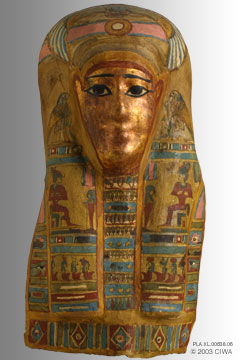Gilded mummy mask of a queen, Dyn. 21

Links to other views:⇒ Larger View⇒ Osiris on throne ⇒ Horus, Osiris, Isis, and Nephtys ⇒ Rosette and Udjat eye ⇒ Falcon ⇒ Osiris (side) ⇒ Back ⇒ Mummy between Isis and Nephtys ⇒ Top if scripting is off, click the ⇒ instead. Links to others from Dynasty 21Bronze shawabti, King Psusennes I, Dyn. 21King Amenemope (?) as Osiris, Dyn. 21 Queen as Isis-Hathor nursing, Dyn. 21 Wax shawabti for bronze casting, Dyn. 21 Links to others of type MaskGilded funerary mask, Dyn. 20 |
This is the cartonnage mummy mask of a queen of Dynasty 21 (1069-945 BC). Such masks, which completely wrap around the back of the head, were slipped on the mummy before it was placed inside its decorated and inscribed coffin for its eternal voyage. Front Her face is gilded (an appropriate color for an defunct that has become one with Osiris), and bordered in red. Her eyes, drawn in sharply contrasting black and white, and extending almost to the ears without looking disproportionate, bring uncanny presence to her otherwise abstractly modeled face. This achieves the effect of a portrait, albeit interpreted through the canons of Egyptian funerary art. Her forehead is adorned with a solar disk embraced by the wings of a scarab (indicative of her royal status). Her face is flanked by falcons rendered in a particularly naturalistic style. On her unusually long headdress, at shoulder level, are mirror images of Osiris seated facing smaller images of the defunct standing and grasping a staff (suggesting she was a ruling queen). Further down the headdress are two groups of four divinities crouching. On the left are Nephtys wearing her Lady of the Mansion hieroglyphic name on her head, Isis also wearing her name, Horus wearing the crown of Lower Egypt, and Osiris wearing the atef crown. On the right are Horus wearing the solar disk, Osiris wearing the crown of Lower Egypt, Isis wearing the solar disk, and Nephtys. Further out are traditional rosettes and Udjat Eyes. Sides On each side, at the same level as the falcons, are crouching representations of Osiris (on her right) and Horus (on her left) each wearing the atef crown. Top Atop her head, the vulture goddess Nekhbet is shown wearing the atef crown, stretching out her wings in protection of the queen. Back The knot in her headband doubles as the hieroglyphic sign sa (“protection”), flanked by the goddesses Wadjet and Nekhbet as snakes. Wadjet, goddess of the delta, wears the crown of Lower Egypt, and Nekhbet, goddess of Upper Egypt, wears the atef crown. Beneath is the mummified defunct herself, standing between Nephtys (left) and Isis (right), wearing their hieroglyphic names on their heads. Cartonnage Cartonnage was a material used in the production of personal funerary ornamentation (masks, pectorals, foot casings, and sometimes whole coffins). It was made with several layers of linen glued together and shaped in a mold. The resulting shell was usually coated on one side with gesso (a mixture of glue and whiting plaster). This smooth medium was well suited to detailed painting and gold leafing. Although earlier examples are known, it is around Dynasty 18 that cartonnage became a material of choice, and it remained a popular medium though the roman period. In later times, the linen layers were sometimes replaced with recycled papyrus documents. Many of the papyri currently studied by Egyptologists were recovered from cartonnage. Bibliography (for this item)Khalil, Hassan M.1976 Preliminary Studies on the Sanusret Collection. Manuscript, Musée l’Egypte et le Monde Antique, Monaco-Ville, Monaco. ([2]27-31) Bibliography (on Cartonnage)Duke University,1991 Duke Papyrus Archive. http://scriptorium.lib.duke.edu/papyrus/, Durham, NC. Lucas, A., and J.R. Harris 1999 Ancient Egyptian Materials and Industries (unabridged republication of the 1962 fourth edition by Edward Arnold Publishers). Dover Publications, New York, NY. |